
Online collections
monedastodas.com
All collections » Tokens » Richardson's Bluecoat Boy Halfpenny
A halfpenny from Richardson, Googluck, & Co, which owns lottery ticket kiosks in London.
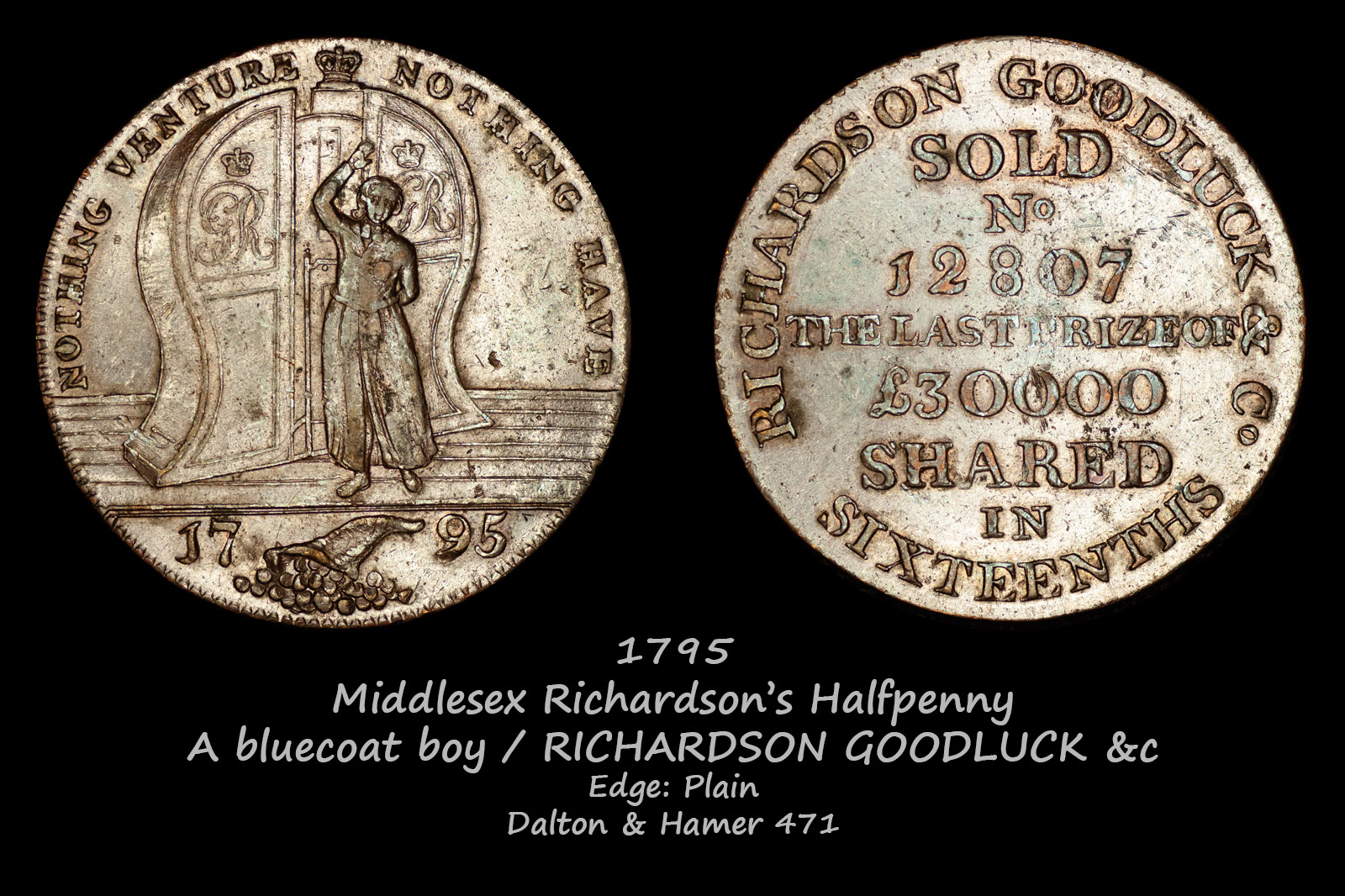
The front side shows Bluecoat Boy, a student at Christ's Hospital in London, standing in front of a large lottery wheel with his right hand above his head and his left behind his back. Legend: "NOTHING VENTURE NOTHING HAVE" (Who does not risk does not win) and the date 1795, separated by a cornucopia at the bottom, from which coins are pouring.
More than four and a half centuries ago, the City of London gathered the orphans and children of the poor and organized a school in Christ's Hospital. The early form followed the Tudor style and was very colorful. It consisted of a long blue coat with a sash at the waist that can be worn with matching knee-length breeches, yellow socks, and white sashes around the neck. The lining of the coat was dyed yellow. The girls wore the same coat with a skirt. It was believed that the color blue was chosen because the dye was cheap, and yellow was chosen to distinguish children from the school of Christ from children attending other schools. The buttons depicted the founder of the school, King Edward VI. The element of diversity was only in the choice of shoes.
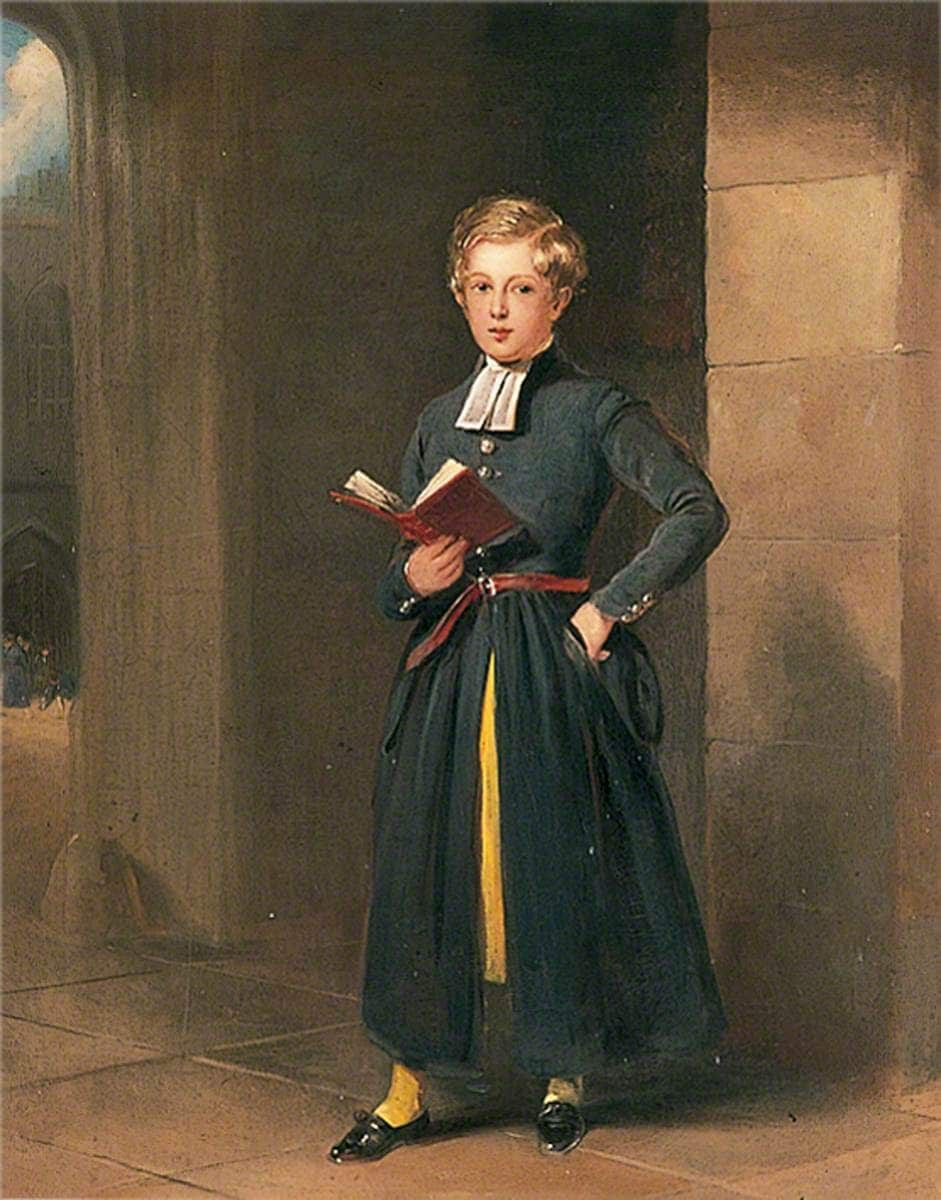 Portrait
of a Christ's Hospital Boy, attributed to Margaret Carpenter (1793-1872). Apart
from the yellow petticoat, the uniform remains very much the same today.
Portrait
of a Christ's Hospital Boy, attributed to Margaret Carpenter (1793-1872). Apart
from the yellow petticoat, the uniform remains very much the same today.Spinning the lottery wheel of Fortune and getting winning tickets was entrusted to the students of the school from Christ's Hospital, as the most disinterested in the outcome. The pose of the student in the blue coat on the token is in accordance with the order of the Treasury: after cases of students being replaced by unknown scammers for personal gain are known, it was determined that before the student can touch the wheel, the organizers must check that the buttons on his chest and sleeves are tight buttoned up, pockets sewn up, and hands examined; and while he is at the wheel, he should keep his left hand behind his belt behind him, and his right hand should be visible with fingers apart.
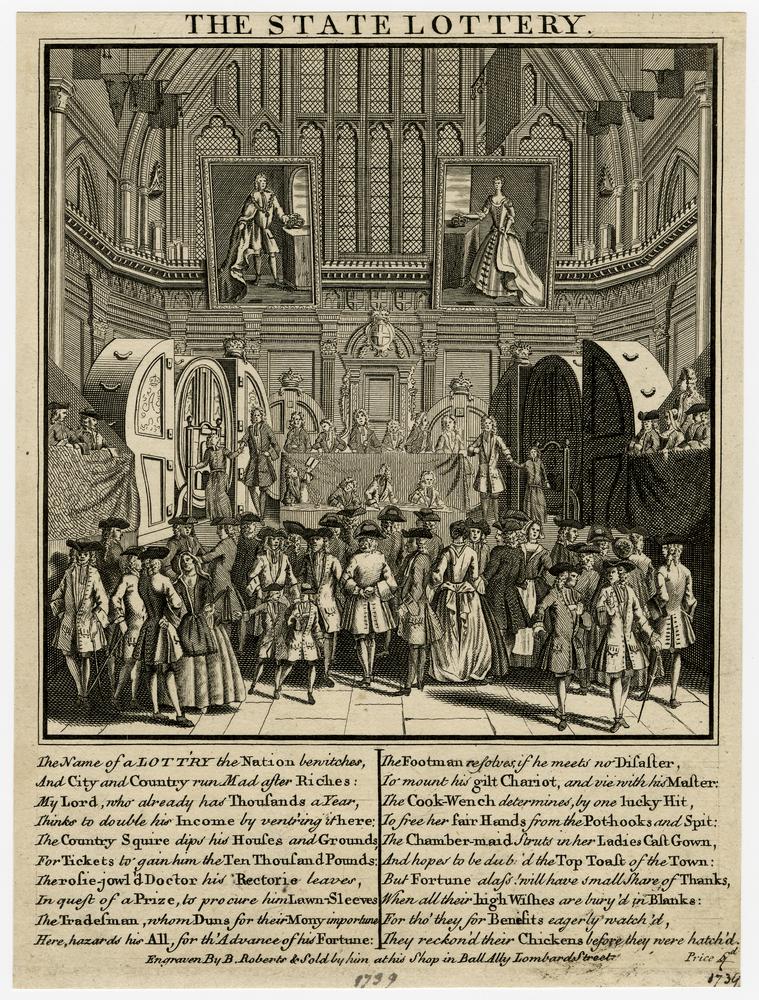
On the one hand, Bluecoat Boy pulled out pieces of paper with ticket numbers from the lottery wheel, and on the other hand, with the size of the winnings, but most often they were empty. In the center sat a commission that recorded the results.
Nine line side inscription on the back: "RICHARDSON GOODLUCK & Co SOLD #12807 THE LAST PRIZE OF £30,000 SHARED IN SIXTEENTHS".
Edge is smooth. Engraver and manufacturer Milton.
The first state lottery in England was held during the reign of Queen Elizabeth I in 1569. The drawing was held daily from January 11 to May 6 in a building specially built for this purpose at the western doors of St. Paul's Cathedral. The reward was cash prizes, plates and other items; The proceeds from the lottery were directed to public needs.
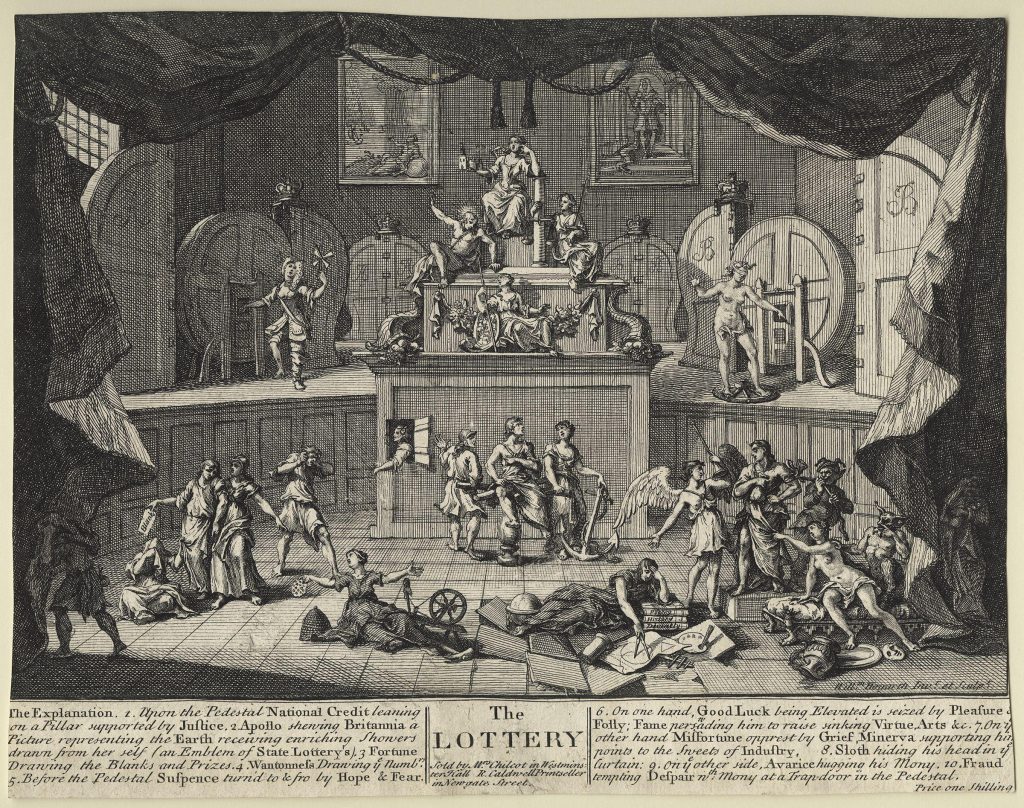 Satirical
print 'The Lottery' by William Hogarth, 1721
Satirical
print 'The Lottery' by William Hogarth, 1721Later, the lottery draw was carried out by licensed lottery companies and agencies, which was an additional source of income for the government. The £10 ticket was sold by the government to lottery companies at £16, who in turn set the price to the public at £20 or more. As a rule, a lottery ticket could be divided into parts, up to 1/16, on which the agencies also made money. The license also regulated the opening hours of the lottery companies from 8 am to 8 pm, with the exception of the Saturday night preceding the draw.
On October 29, 2792, an announcement
was published in the Lloyd's Evening Post:
"Richardson, Goodluck & Co., Bank
Buildings, Cornhill, and opposite the Royal Mews, Charing Cross, realizing the
respect they owe to their friends and the public at large, ask permission to
repeat that it was and always will be their rule not to disclose the names of
the lucky recipients of the grand prizes purchased from their offices. But,
due to the numerous daily inquiries regarding the division of the prize of
thirty thousand No. 12807, played by them in the last State Lottery, in 16 equal
shares, they believe that, yielding to numerous requests to publish the
following list, they will not be suspected of deviating from their rules ". The
following was a list of sixteen lucky winners of £1,875 each.
We must pay tribute to the fact that for more than two centuries, with the money from the sale of lottery tickets, the Briana Museum, the London Aqueduct, several bridges and other important architectural objects were built.
The English State Lottery ran for over 250 years until the Government, under pressure from opposition in Parliament, announced the date for the last lottery to be held on July 18, 1826. This lottery drew ridicule from contemporaries as "the last battle of the speculators in popular trust for the popularity of their last dying lottery".
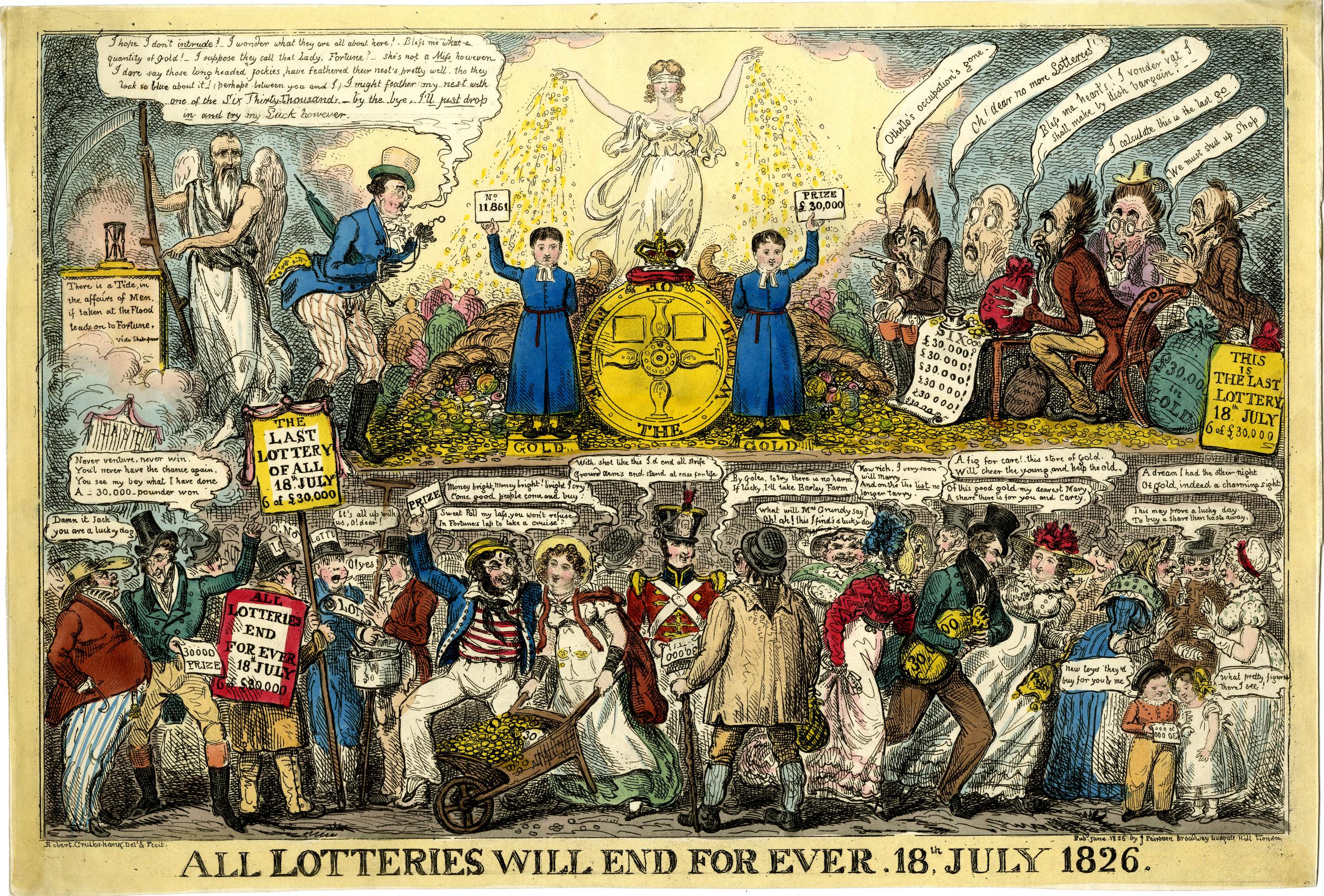 Isaac
Robert Cruikshank, All Lotteries Will End For Ever, 1826, The British Museum
Isaac
Robert Cruikshank, All Lotteries Will End For Ever, 1826, The British Museum
To commemorate the last lottery draw,
Robert Cruikshank released a satirical print. The caricature is
divided into two parts horizontally in such a way that one scene appears to be
above the other. Those at the bottom advertise the latest draw with
mocking phrases previously used by the lottery organizers. Here are
some of them:
On the right side, a gentleman in a top
hat, pointing to a poster that reads "THE LAST LOTTERY OF ALL 18th JULY 6 of
£30.000", is holding a paper with the inscription "30,000" and says to his fat
friend: "He who does not take risks, he doesn’t win, this is your last chance,
look my friend, I won £30,000”, to which he replies: “Damn Jack, you are a lucky
dog.”
In the center is a statuesque soldier
with a paper "30,000", who says: "With such luck, I can throw a gun on the
ground and live freely for the rest of my life", to which an uncouth village
eccentric in shabby clothes replies: "I swear to God, it's not a sin to try . If
I'm lucky, I'll take a barley farm."
Nearby, a pretty girl rolls a wheelbarrow
filled with sovereigns with the words: “Bright money, bright money! I'm
crying out loud! Come in good people, come in and buy." A
cheerful sailor next to her answers her: “Sweet question, my girl, you won’t
refuse. Shall we take a cruise on the Wheel of Fortune?"
At the top of the lottery wheel, adorned with cornucopias, coins and bags of money, Fortune is depicted scattering gold coins from two raised hands. On the sides of it, on golden plates, there are two bluecoat fights with tickets. On the left side, Time with a scythe points to an hourglass on a pedestal with a quote from William Shakespeare: “In the affairs of people there is a moment of tide, it rushes them to Happiness.” Nearby is Liston as Paul Pry, rushing towards a group of lottery agents with outstretched heads seated on the right side to try their luck. Agents are sitting at a table surrounded by bags of gold coins in great dismay and complain about the imminent loss of an easy source of income.